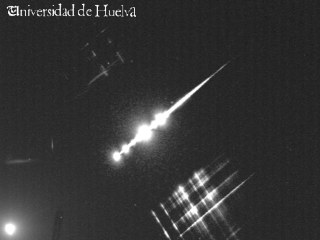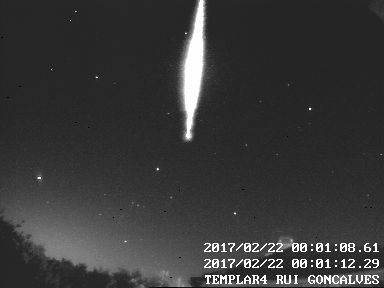On the evening of October 20, 2021, at 18:28 (local time), the lucky ones could see a bright fireball. Due to the early evening time, most meteor camera systems have not yet started. Meteorological cameras and many car cameras, on the other hand, have successfully captured the phenomenon.

Made by Schmall Rafael from Kaposfő, Hungary
Initial data
According to the measurements, the meteor first appearance was at 91 km with an angle of 68 degrees inclination at 17 km/s, it flew 67 km in the atmosphere in just 4 seconds. Meanwhile, it got from Padragkút to Révfülöp, where it was last seen at an altitude of 24.8 km. I used only the images of the meteorological cameras for the measurement, before the information calculated from the professional systems is publicated. I used UFOAnalyser and UFOOrbit (Sonotaco, 2009) for the trajectory calculation.

Calculated trajectory above lake Balaton, Hungary
Dynamical mass
By measuring the best recording from the end of the fireball trajectory, I was able to get closer to calculate the remaining mass. This picture was from one of the cameras on the VMETEO site, which saw the end of the fall up close (from Veszprém, from a distance of 40 km). Bence Gucsik saved star background pictures from that camera and asked Mónika Landy-Gyebnár (camera operator) for the exact coordinates of the camera. The camera recorded the last moments of the fall on 7 frames, measuring them frame by frame provides the basis for the current mass and strewn field calculation.
As this camera was the closest to the fall, it could see the end better. The meteor could be tracked on the recording far more, than from another cameras, down to an altitude of 24.8 km. During this time, its speed decreases from 9 km/s to 3.75 km/s. Let’s not forget, that while this is the last light we see under the fall, it doesn’t mean the body has switched to dark flight here. The picture was taken in clear skies and this camera is not so sensitive to dim lights. Therefore, the remaining mass probably got a few hundred meters deeper than that. Continuing the rate of deceleration, the assumed final altitude is 24.6 km at 2.5 km/s.
From the speed measured frame by frame, knowing the deceleration and the current altitude, one can calculate how much weight makes this movement. (Halliday et al. 1996) Based on this, we see the movement of a 1.2 kg body on the last frame. Once again… this is not the end of the ablation, so it has fallen even further and ablated presumably below 1kg. However, based on the recording, this is done by 1 body throughout the flight. If it was torn into several pieces at the end, it was apparently not separated from this distance (about 40 km) Continue the ablation process, the Monte-Carlo modeling spread around 880 g.
Strewn field calculation
I modeled the dark flight with these data in two different (data came from University of Wyoming, Atmospheric sounding) wind profile 12 UT and 00 UT from Budapest. The remaining mass was given as 100 g – 1 kg. The starting height of the bodies varies from 25.1 km to 24.6 km, along the calculated trajectory. The gravitational deflection – the difference between the calculated straight line path and the real curved trajectory – was not taken into account (it was only 27m) because it’s negligible compared e.g. to wind measurement uncertainties. My program doesn’t handle in-flight fragmentation yet, so it’s even possible to find smaller pieces at the ‘big’ end of the strewn field, but it has to be still in the calculated field. Unfortunately, the results for the 12 UT and 00 UT models are very different. Since the fall was between the two – at 16:28 (UT) – it can be assumed that the fallen pieces are likely to be between the two calculated strewn fields.
For this fireball, many parameters and observed conditions support the probability of meteorite fall. So I posted a little article about it on Facebook. After this, there were some people who dedicated they time to search the area individually but this yielded no findings.
Czech professional astronomers (Pavel Spurný et al. 2021) have also calculated data from this fireball, based on images captured by cameras from the European Fireball Network. They have also published their results, from which much can be learned for a citizen scientist like me. Their calculated trajectory came out 800 meters west (yellow) from mine (white), and the final altitude was calculated to be 26 km, instead of the 24.8 what I had calculated. Partly because of this – due to the difference in height – the center line of their calculated strewn field shifted 1.2 km to the SE compared to what I calculated. Based on their published information, I also calculated the strewn field, this can be seen at the edge of the yellow field they calculated. So it can be seen that the strewn field started from above, started pushing the result onto their field (yellow), but that alone is not enough to fully match the results. Unfortunately, I don’t know what causes the further difference, because I don’t have either their exact starting data or the program they’re counting with. I use my own program to calculate the strewn field.

The two different trajectories

Different strewn field calculations
What is encouraging, however, is that there are no huge differences. They also gave a few hundred grams to the remaining mass. It can be seen that calculated only from the images and videos of meteorological cameras, the fall can be approached within 1000 m.
Orbit
Before the collision of Earth atmosphere this fragment follows a bit unusual orbit around the Sun. In general the fireballs come from between Mars and Jupiter, but this one barely reached the orbit of Mars. Therefore, this one was definitely a piece of the innermost part of the main asteroid belt.
The resulting orbital elements are:
- α = 273.9°
- δ = +68.6°
- a = 1.2 A.U.
- q = 0.993 A.U.
- e = 0.186
- ω = 191.2°
- Ω = 207.2°
- i = 24.2°

Calculated orbit in UFOOrbit (Sonotaco, 2009)
References
- SonotaCo (2009). “A meteor shower catalog based on video observations in 2007-2008”. WGN, Journal of the International Meteor Organization, 37, 55–62.
- University of Wyoming – http://weather.uwyo.edu/upperair/sounding.html
- Halliday et al. (1996) Halliday, I., Griffin, A.A., Blackwell, A.T. (1996): Detailed data for 259 fireballs from the Canadacamera network and inferences concerning the influx of large meteoroids, Meteoritics & PlanetaryScience, 31, pp. 185 – 217
- Pavel Spurný et al. 2021 – RNDr. Pavel Spurný, CSc., RNDr. Jiří Borovička, CSc. a Mgr. Lukáš Shrbený, Ph.D. Oddělení meziplanetární hmoty
Astronomický ústav AV ČR









